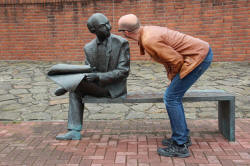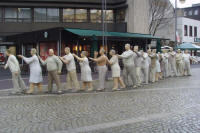Relating experiences

Why is the skill important?
The ability to relate a story, tell an anecdote or explain what
has happened in life is useful for a number of purposes.
Think of three reasons why someone might want to relate an
experience
and then click here.
- To oil the wheels of social interaction.
It has been suggested that almost half of all social interaction consists of the relation of anecdote. Not to be adept at doing so excludes people. - To illustrate a point of view.
We often use personal experience as exemplification for an opinion we are putting forward. Often, the experience is explained in terms of a story or anecdote. - To offer excuses and justification.
For example, excuses for lateness often require the relating of why one is late and the justification or explanation for present actions or states also often relies on relating what led up to them.
Which of the following introductions is an
example of these three purposes?
Click here when you have an answer.
- Story 1
- It may be true that it's hard being a student these days but I remember when I was at college we would often ...
- Story 2
- I know, sorry. I've actually had a rather difficult time getting here. I got to the station as usual and ...
- Story 3
- That reminds me of the time I was travelling around India. We fetched up in a little village in Andhra Pradesh and ...
- Story 1
- This is illustration of a point of view. The speaker is presumably going on to tell a story to illustrate how hard times were when she was a student.
- Story 2
- This is justification, presumably for being late. The speaker is eliciting forgiveness through explaining how the lateness occurred.
- Story 3
- This is oiling the wheels. The speaker is taking over a turn (often a long one) by picking up on something said and launching into an anecdote.
 |
Staging the information |
There are two possible structures for telling a story. They are closely allied but different in one important respect. Here they are. What's the difference between them?
| Recount | Narrative | |||
| Orientation | who? where? when? | Orientation | who? where? when? | |
| Record of events | usually in chronological order | Complication | crisis or problem with evaluation | |
| Reorientation | summarising | Resolution | how was the problem resolved? | |
| Coda | personal comment | Coda | personal comment | |
In a recount, we are simply setting out what happened. In a narrative, we are following more closely the structure of fiction which normally involves some kind of crisis or problem and sets out its resolution. The latter is frequently the structure of anecdote; the former of justification, explanation and illustration of a point.
Let's be clear:
There is no point at all in teaching
the language and structures we typically use in relating stories
unless your learners know how to structure the tale. Their
first languages may well do it differently.
 |
Raising structural awareness |
There are a number of ways to do this but one effective solution is to take a genre approach to speaking / writing and analyse an example before asking learners to construct a text. Here's a way.
Match the stages to the text by drawing arrows between them. Click on the story when you have an answer.

 |
The language we use |
The focus on language in this area is often confined to the use of what are referred to (somewhat loosely) as narrative tenses. That is less than half the story but an important part of it.
 |
Tenses |
There are separate guides to tense forms on this site that you may like to look at.
The dramatic present
Usually narratives and recounts are set in the past with past-tense forms being used. However, especially in spoken English, the dramatic present can be used to add punch and immediacy. For example, the speaker here could have said
- Suddenly a policeman appears and takes me out of the queue.
- My girlfriend is waiting on the other side.
This is quite easy to handle and may be appropriate, especially at lower levels, because it allows learners to use familiar tense forms naturally.
Perfect aspects
Despite its usefulness, the past perfect is not commonly used except for causally related events. However, some skilful speakers might choose to orientate the listener retrospectively with something like
- We had taken the ferry from Spain.
Notice that in this story the causal relationship is pointed out with
- I was really upset because my girlfriend had already passed through.
In stories intended to justify or excuse a present action or state, the present perfect is common to set the scene. It is also routinely used to set the scene in news reports (both written and spoken) and is followed by a normal recount in the past. It is not appropriate for our example story here, but we often get sentences like
- I know I'm late but I've had a terrible time getting here.
- Three men have been arrested following a police raid. The arrests took place in ...
Future in the past
At the complication stage of a narrative, when saying what the problem was, the future in the past is common so we could get
- My girlfriend would have been in Morocco alone.
- If the barber hadn't arrived, I wouldn't ...
Note the use of speculative third conditional forms. It's reasonably common in anecdotes.
Past tenses
Most events are related in past simple because that is what they
are: finished past events. The finite is common, therefore.
In the example above, almost all the verbs are in the past
simple.
For background, we may use the progressive aspect
of the tense and could get, for example
-
The sun was shining brightly and it was really hot.
In this story, we do have
-
We were standing in the hot sun.
The second of these refers to progressive actions, the first to a continuous event.
What goes where?
It is important to distinguish which tense forms are likely to occur at which stage of the story. This means that you can devote teaching time to each stage and really focus.
- Orientation:
present perfect – I've had a terrible time this morning ..., Customs officers have discovered ...
past progressive – I was sitting on the train this morning when ..., We were travelling through France last year and ...
past simple (event) – This happened when I was in Germany., She took the train this morning but ...
past simple (state) – I was on holiday in Russia when ..., We were at university together and ... - Situations and events:
past simple – A friend got on the bus. Someone called to me.
past perfect (causal) – I recognised him because ..., I was frightened because the man had taken my passport. - Complications and problems:
future in the past – I knew there would be a problem because my visa was invalid. I thought the policeman would arrest me.
past simple (events) – He stole my money. I lost my wallet. - Coda:
Past simple (states) – I felt ..., I thought ...
 |
Verb types |
There is a separate guide to verbal processes on this site, linked below, which will explain further. Briefly, because texts of this sort are used to describe what happened, what people did and what they said about it, we need to deploy and understand:
- MATERIAL processes: events and states, for example:
the ferry docked
the policeman pulled me out of the line
etc. - BEHAVIOURAL processes: how participants felt, for example:
I was upset
she was waiting
etc. - VERBAL processes: who said what to whom. for example:
the police officer said
my girlfriend explained
etc. - MENTAL PROCESSES: how people felt, for example:
I thought
I felt
etc.
These are frequently used in the coda.
 |
Circumstances |
There is also a separate guide to circumstances on this site, linked below. The important ones for our purposes here are:
| Circumstance | Examples from the text |
| EXTENT | for what seemed like a very long
time in the end |
| LOCATION | to the front of the queue in the 70s |
| CAUSE (and consequnce) |
to make myself respectable as my girlfriend had already passed through this meant that ... |
| ACCOMPANIMENT | with my girlfriend in the queue |
Learners need to be able to handle these before they can relate
effectively.
In a more structural analysis, these kinds of meanings are usually
expressed through adverbs, prepositional phrases, causal clauses and
noun phrases.
 |
Teaching the skill |
There is a temptation, worth resisting, to assume that learners simply need practice in recounting events or telling narratives but that won't usually work because without explicit teaching of the facets of relating experience, learners will do three things, none good:
- They will assume, unless it is made clear otherwise, that a
narration or recount in English will follow the same staging as
one in their first language(s).
This may be the case within some cultures but is certainly not the case for all. - They will deploy language they are sure of rather than the more complex ways of setting events and states in time relative to each other and making circumstances clear.
- They will often place the coda at the beginning because, for many, that seems a logical place.
![]()
Take a recount of a narrative (depending on your targets for later
production) and analyse the staging together. You may have to
do this more than once.
![]()
Focus on the types of verbal processes and the lexis the learners
will need successfully to relate the story.
![]()
Focus on the tense structures. depending on the level of the
learners and on how well they can already use the main narrative
tense forms, this may take some time or be a reminder. Looking
at the types of verbs used in an example narrative or recount and
analysing the forms and meanings is a good way to do this. A
classification exercise categorising the types of processes involved
is also useful.
![]()
Focus on circumstances (or adverbial structures, if you prefer) to
be able to say:
- where the event happened using spatial expressions such as
in the forest
overseas
outside
in the middle of the town
etc. - when it happened using temporal constructions such as:
last year
before I reached the station
in 1963
at the end
after all
etc. - who was with them using accompaniment structures such as:
all of us
with some friends
as part of the group
etc. - causal and consequential constructions such as:
in order to
because we needed to
so that we could
Accordingly, ...
Consequently, ...
As a result, ...
etc.
Subordinating conjunctions and causal / consequential conjuncts are particular useful.
![]()
Put it all together.
Do not be tempted to rush this stage.
Learners need, especially at the outset, to have time mentally to
rehearse their recount or narrative, running through it in their
heads only before they venture to tell the story orally.
One way to allow for this is to get learners to write the text (as
in an email to a friend) before being asked to produce the text
orally. Writing it first and then telling it orally is often a
useful focusing procedure because time pressures are removed.
It may seem dull to you to repeat the entire anecdote or whatever to
another person two or three times but it is not to the learners.
Repeating the narration or recount multiple times usually means
making adjustments and refining the way the story unfolds.
This can be done with a simple mingling exercise with people
circulating among their peers telling their stories and listening to
other people's narratives.
Now, too, is an obvious time to focus on back-channelling devices to
which, naturally, there is a guide on this site, linked below.
Here's a summary with a little more detail:

The ordering of events may depend on you, your class and their
needs. However, make sure that at least the learners know how
a typical text is staged and structured (step 1) before you go
on to the rest or the outcomes will be disappointing (for everyone).
At lower levels in particular, you need to break the story down into
its stages and teach the language that is required for that stage
only. You should not expect learners to produce the whole
story from scratch in one lesson (or even one day).
| Related guides | |
| verbal processes | for more about what verbs do and how to classify them by function rather than structure |
| circumstances | for the guide to this area from a functional point of view |
| back-channelling | for the guide to this area which forms a natural counterpart to recounting and narration |
| functions index | for the index to allied areas |
References:
Butt, D, Fahey, R, Feez, S, Spinks, S and Yallop, C, 2001, Using Functional
Grammar: an explorer's guide. Sydney: NCELTR
Halliday, M, 1994, An introduction to functional grammar: 2nd
edition. London: Edward Arnold
